The goal of this project is to foster the pleasure of learning science, physical and natural phenomena - in this case the astronomy - through the construction and manipulation of materials that promote the taste for this subjects.
Throughout the project the primary students can build a small astronomy book with three parts: stars and planets, the solar system and the moon phases.
To each part is devoted a session of about an hour to perform the assembly of the different pages.
The construction of the book may be accompanied by theoretical sessions that allow a first contact with each of the topics covered.
All materials are available HERE.
The book
The goal of this book construction is to motivate students for the study of astronomy, and other sciences of the future.
For each book, A4 format, the following materials are needed:
- 5 printed sheets (A3) folded to be the different pages of the book;
- 1 printed sheet (A4) with images of the planets;
- 3 printed acetates (A4) with the orbits of the planets;
- 1 printed sheet (A4) on the phases of the Moon;
- 4 black cardstock (A4) that serve to unite the different pages with each other;
- 1 cardboard (A3) folded to form the cover and the book cover;
- 1 printed sheet (A4) with the logo to glue on the cover;
- 1 paper fastener;
- glue.
Each set of sessions (Stars and Planets, the Solar System and Moon Phases) correspond two book pages (pages 2 to 7 of the book).
Each theme is treated differently allowing always have a look and different activities of the other two issues.
Each set of pages have brief texts and/or information, and an assembly/collage, performed by the student, appropriate to the subject.
Cover and back cover
The cover and the back cover are made of a single black cardboard A3 size, with the project logo glued on the front.

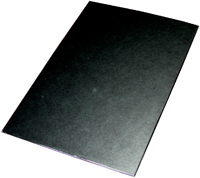
Initial pages
The initial pages of the book are only to identify the person who builds the book.
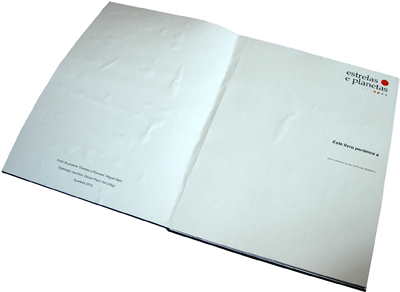
Stars and Planets
The main point of interest of these two pages is the pop-up on the various celestial bodies of the Solar System: stars, constellations, galaxies, planets, dwarf planets, asteroids, comets and natural satellites.
In these pages the student can also paint a star (Sun) and a planet (Earth), and try to identify the stars of a constellation (Ursa Major).
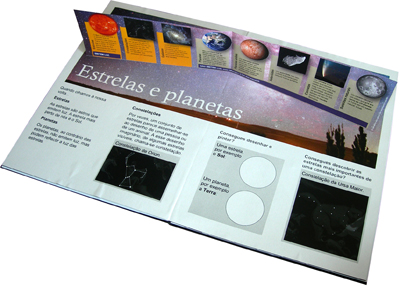
The Solar System
These pages are devoted to the main objects of the Solar System: the Sun and the eight planets.
The first page contains places for glue images of the eight planets of the Solar System. The relative sizes of the sun (partially visible at the top of both pages) and the planets is correct.
On the second page is built a simplified model of the Solar System. This model is made with acetates, representing the different planetary orbits. The planets can rotate independently around the Sun (represented by a paper fastener that unites acetates to the book).
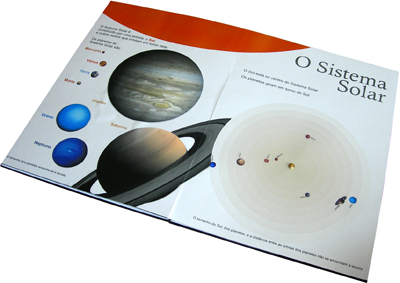
Moon phases
This pages are dedicated to the phases of the Moon (New Moon, First Quarter, Full Moon and Third Quarter).
The first page explains why the phases of the Moon exist - why we see the Moon in different ways.
The second page has two collages with four windows each, which allow a little game on the different phases of the Moon. The student should raise one of the windows that are on the Moon and watch the Moon phase image. Then he/she should raise one of four windows lying at the bottom of the page to match the phase of the Moon name with the image previously observed.
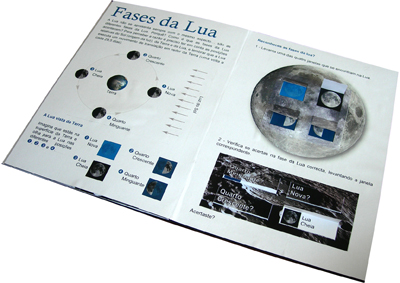
Final pages
The last pages of the book contain some sites on the internet where students can find more information about astronomy.
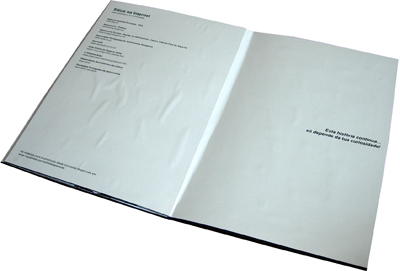
Photos and video
Here you can view photos and a video of the implementation of the entire project.
Publications/Information
Presentation of the project in ACE2010 - Astronomy and Space Sciences, Espinho, Portugal, May 29, 2010 [.pdf, Portuguese version]
Information published in the DGIDC Bulletin # 4 [.pdf, Portuguese version]
Accepted for publication on the Casa das Ciências website on January 31, 2011 [available at THIS address, Portuguese version].
Winner of the Excellence Award of the Casa das Ciências prize in 2011 [.pdf, Portuguese version]
Information published in the Newsletter #2 of the Galileo Teacher Training Program [.pdf]
Stars and Planets project report [.pdf, Portuguese version]
Workshop at Casa das Ciências First international Meeting [Portuguese version].
![]()
![]()
